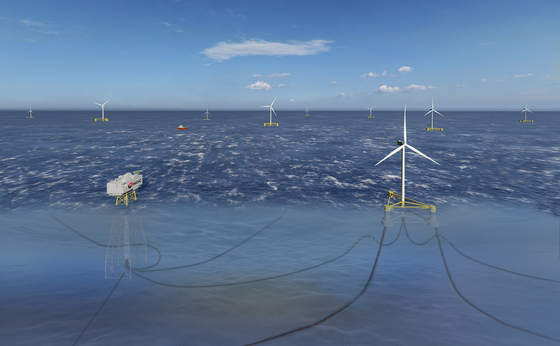By 2034, a quarter of domestic power generation is expected to be filled with renewable energy. It will also promote the localization of core technologies such as high-efficiency solar cells, ultra-large wind turbines (12mW or more), green hydrogen mass production, and water heat. The government held a new and renewable energy policy council on the 29th and deliberated and confirmed the ‘5th basic plan for the development, use and distribution of new and renewable energy technologies’.
According to this, the share of new and renewable energy generation will increase to 25.8% by 2034, emerging as the main energy source. Specifically, 22.2% of renewable energy, such as solar and wind power, and 3.6% of new energy, such as hydrogen and fuel cells. As of 2034, the capacity of new and renewable energy (for business + private use) is 82.2GW.
![Korea National Oil Corporation spurs floating offshore wind power project in Ulsan. [연합뉴스]](https://i0.wp.com/pds.joins.com/news/component/htmlphoto_mmdata/202012/29/22253145-ab5a-4a37-8bb7-27d580af4a69.jpg?w=560&ssl=1)
Korea National Oil Corporation spurs floating offshore wind power project in Ulsan. [연합뉴스]
In order to expand the supply of new and renewable energy, the government decided to introduce the wind power one-stop shop, an integrated wind power licensing organization, and to extend the site rental period in line with the increase in the life of the facility. Regulations related to licensing, such as separation distance, will also be improved. In addition, it plans to establish a regional energy center and strengthen incentives for excellent local governments to encourage the spread of new and renewable energy led by the region.
The new and renewable energy obligation fulfillment cost (RPS) market will also be reorganized to increase the profitability of business operators. Reorganize focusing on long-term competitive bidding contracts and review market separation by energy source. The RPS mandatory ratio will be raised to 40% by 2034, and the standard for power generation facilities will be lowered from 500MW to 300MW, increasing the number of mandated supplies from 23 to 30 next year. We will also review ways to provide incentives such as self-consumption type RECs to activate renewable energy for private use. Renewable energy that exceeds the demand for each time period is promoted to apply a’storage mix’ that is used at different times after discounting weekly rates or storing.
Along with this, the government decided to foster 1,000 hydrogen specialized companies and 100 energy innovative companies with sales of 100 billion won or more to revitalize the hydrogen industry. The scale of R&D support for hydrogen materials, parts and equipment will increase to 200 billion won by 2030.
The new and renewable energy basic plan, which is established every 5 years for a period of 10 years or more, contains mid- to long-term goals and implementation plans in the new and renewable energy sector in connection with the’Basic Energy Plan’, the highest plan in the energy sector.
Sejong = Reporter Seongbin Lim [email protected]
